Legal System for Business Law: Classifications, Sources, and UK Law Making Process
VerifiedAdded on 2023/06/12
|8
|2485
|351
AI Summary
This report covers the legal system for business law, including classifications of law, sources of law, and the UK law making process. It explains civil and criminal law, case law, delegated legislation, and employment law. The report also discusses the role of courts in the English legal system.
Contribute Materials
Your contribution can guide someone’s learning journey. Share your
documents today.
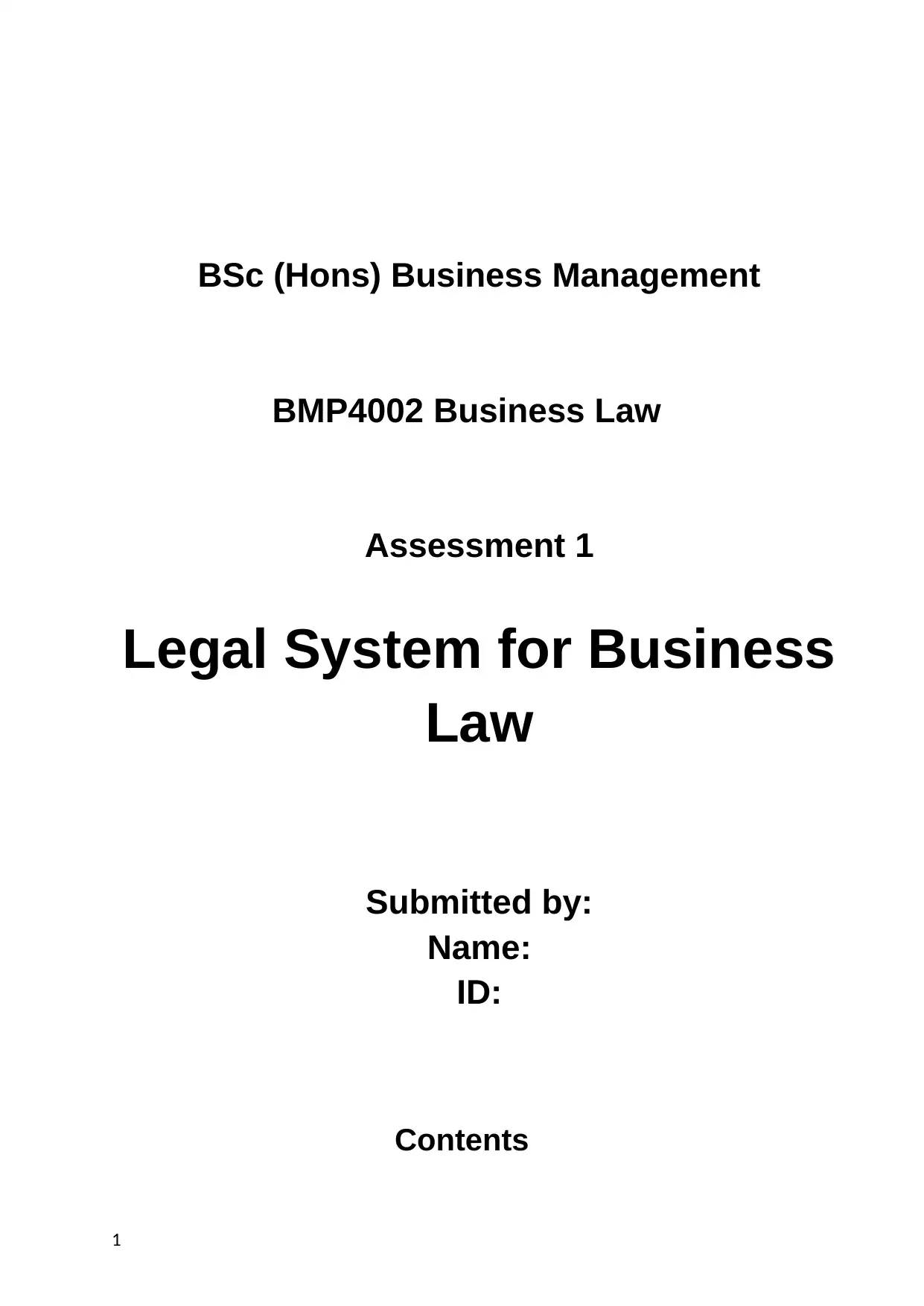
BSc (Hons) Business Management
BMP4002 Business Law
Assessment 1
Legal System for Business
Law
Submitted by:
Name:
ID:
Contents
1
BMP4002 Business Law
Assessment 1
Legal System for Business
Law
Submitted by:
Name:
ID:
Contents
1
Secure Best Marks with AI Grader
Need help grading? Try our AI Grader for instant feedback on your assignments.
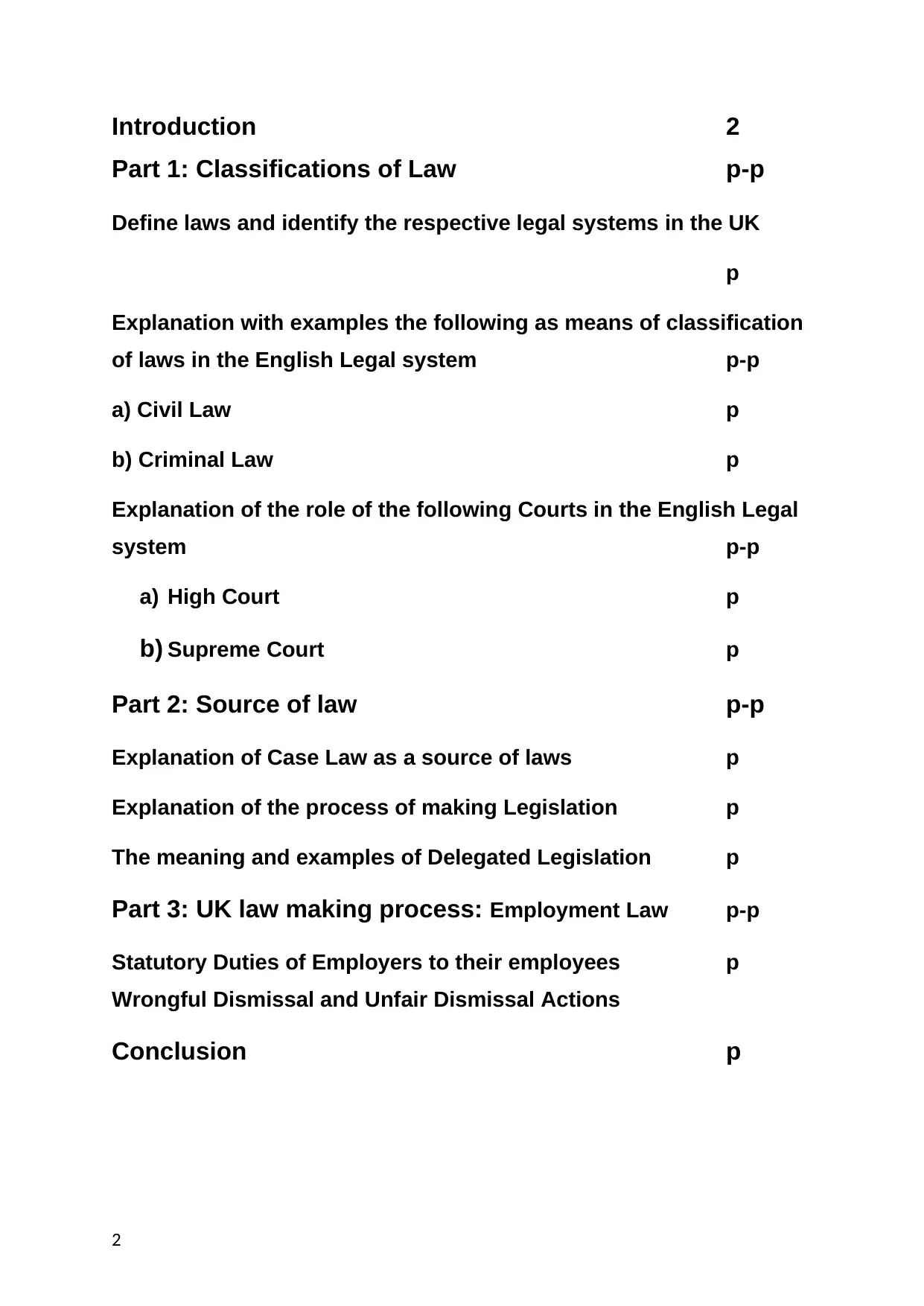
Introduction 2
Part 1: Classifications of Law p-p
Define laws and identify the respective legal systems in the UK
p
Explanation with examples the following as means of classification
of laws in the English Legal system p-p
a) Civil Law p
b) Criminal Law p
Explanation of the role of the following Courts in the English Legal
system p-p
a) High Court p
b) Supreme Court p
Part 2: Source of law p-p
Explanation of Case Law as a source of laws p
Explanation of the process of making Legislation p
The meaning and examples of Delegated Legislation p
Part 3: UK law making process: Employment Law p-p
Statutory Duties of Employers to their employees p
Wrongful Dismissal and Unfair Dismissal Actions
Conclusion p
2
Part 1: Classifications of Law p-p
Define laws and identify the respective legal systems in the UK
p
Explanation with examples the following as means of classification
of laws in the English Legal system p-p
a) Civil Law p
b) Criminal Law p
Explanation of the role of the following Courts in the English Legal
system p-p
a) High Court p
b) Supreme Court p
Part 2: Source of law p-p
Explanation of Case Law as a source of laws p
Explanation of the process of making Legislation p
The meaning and examples of Delegated Legislation p
Part 3: UK law making process: Employment Law p-p
Statutory Duties of Employers to their employees p
Wrongful Dismissal and Unfair Dismissal Actions
Conclusion p
2
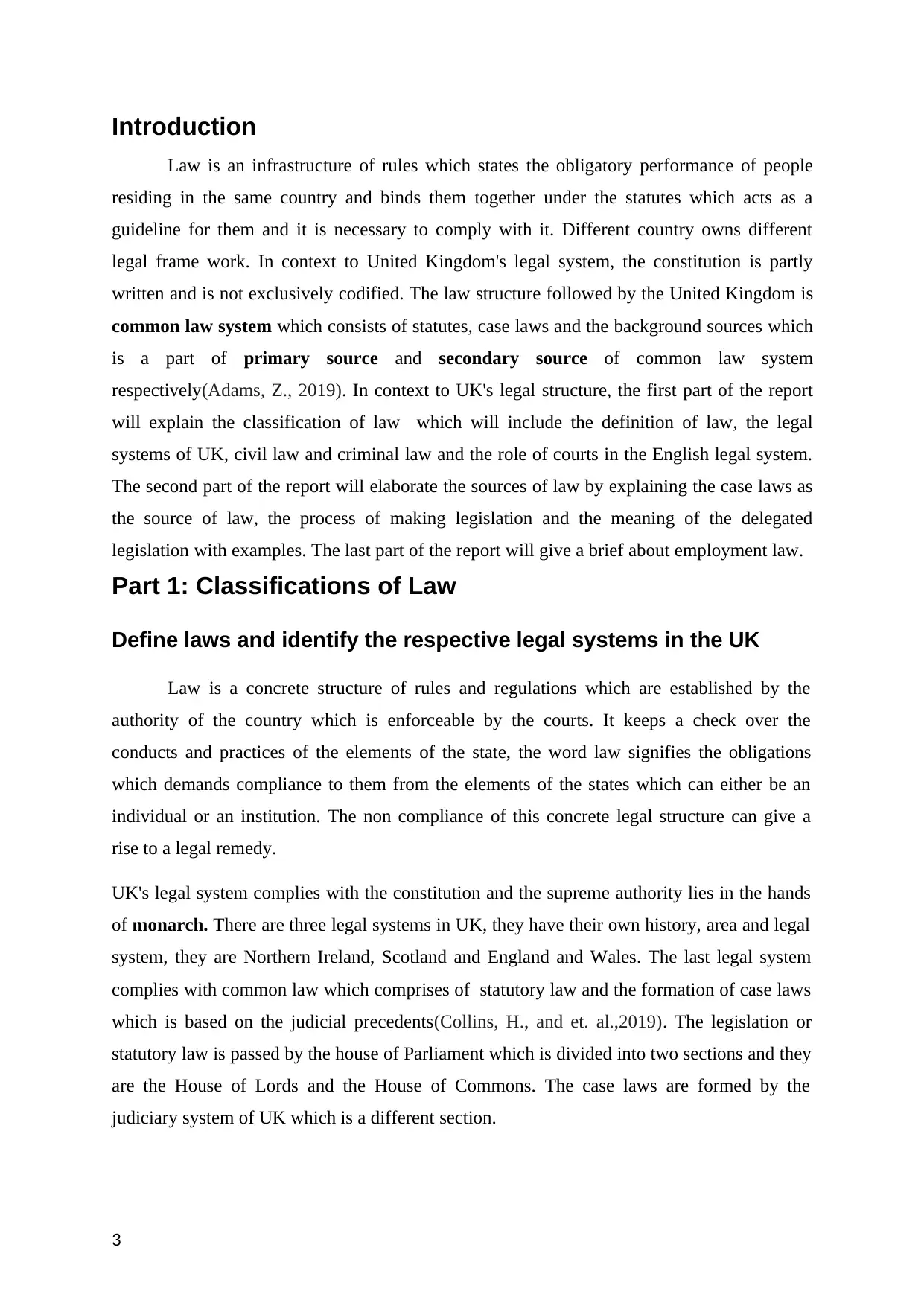
Introduction
Law is an infrastructure of rules which states the obligatory performance of people
residing in the same country and binds them together under the statutes which acts as a
guideline for them and it is necessary to comply with it. Different country owns different
legal frame work. In context to United Kingdom's legal system, the constitution is partly
written and is not exclusively codified. The law structure followed by the United Kingdom is
common law system which consists of statutes, case laws and the background sources which
is a part of primary source and secondary source of common law system
respectively(Adams, Z., 2019). In context to UK's legal structure, the first part of the report
will explain the classification of law which will include the definition of law, the legal
systems of UK, civil law and criminal law and the role of courts in the English legal system.
The second part of the report will elaborate the sources of law by explaining the case laws as
the source of law, the process of making legislation and the meaning of the delegated
legislation with examples. The last part of the report will give a brief about employment law.
Part 1: Classifications of Law
Define laws and identify the respective legal systems in the UK
Law is a concrete structure of rules and regulations which are established by the
authority of the country which is enforceable by the courts. It keeps a check over the
conducts and practices of the elements of the state, the word law signifies the obligations
which demands compliance to them from the elements of the states which can either be an
individual or an institution. The non compliance of this concrete legal structure can give a
rise to a legal remedy.
UK's legal system complies with the constitution and the supreme authority lies in the hands
of monarch. There are three legal systems in UK, they have their own history, area and legal
system, they are Northern Ireland, Scotland and England and Wales. The last legal system
complies with common law which comprises of statutory law and the formation of case laws
which is based on the judicial precedents(Collins, H., and et. al.,2019). The legislation or
statutory law is passed by the house of Parliament which is divided into two sections and they
are the House of Lords and the House of Commons. The case laws are formed by the
judiciary system of UK which is a different section.
3
Law is an infrastructure of rules which states the obligatory performance of people
residing in the same country and binds them together under the statutes which acts as a
guideline for them and it is necessary to comply with it. Different country owns different
legal frame work. In context to United Kingdom's legal system, the constitution is partly
written and is not exclusively codified. The law structure followed by the United Kingdom is
common law system which consists of statutes, case laws and the background sources which
is a part of primary source and secondary source of common law system
respectively(Adams, Z., 2019). In context to UK's legal structure, the first part of the report
will explain the classification of law which will include the definition of law, the legal
systems of UK, civil law and criminal law and the role of courts in the English legal system.
The second part of the report will elaborate the sources of law by explaining the case laws as
the source of law, the process of making legislation and the meaning of the delegated
legislation with examples. The last part of the report will give a brief about employment law.
Part 1: Classifications of Law
Define laws and identify the respective legal systems in the UK
Law is a concrete structure of rules and regulations which are established by the
authority of the country which is enforceable by the courts. It keeps a check over the
conducts and practices of the elements of the state, the word law signifies the obligations
which demands compliance to them from the elements of the states which can either be an
individual or an institution. The non compliance of this concrete legal structure can give a
rise to a legal remedy.
UK's legal system complies with the constitution and the supreme authority lies in the hands
of monarch. There are three legal systems in UK, they have their own history, area and legal
system, they are Northern Ireland, Scotland and England and Wales. The last legal system
complies with common law which comprises of statutory law and the formation of case laws
which is based on the judicial precedents(Collins, H., and et. al.,2019). The legislation or
statutory law is passed by the house of Parliament which is divided into two sections and they
are the House of Lords and the House of Commons. The case laws are formed by the
judiciary system of UK which is a different section.
3
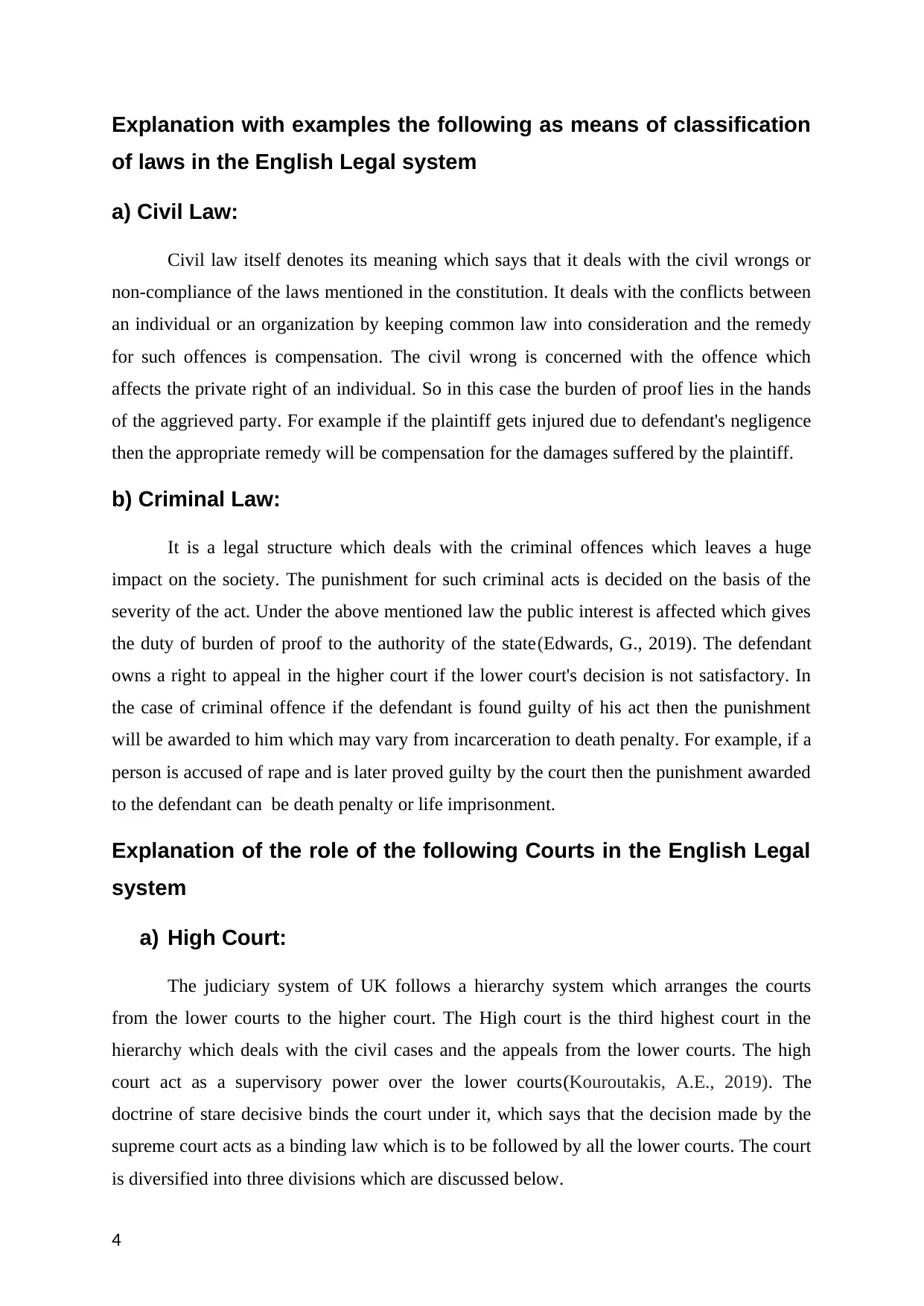
Explanation with examples the following as means of classification
of laws in the English Legal system
a) Civil Law:
Civil law itself denotes its meaning which says that it deals with the civil wrongs or
non-compliance of the laws mentioned in the constitution. It deals with the conflicts between
an individual or an organization by keeping common law into consideration and the remedy
for such offences is compensation. The civil wrong is concerned with the offence which
affects the private right of an individual. So in this case the burden of proof lies in the hands
of the aggrieved party. For example if the plaintiff gets injured due to defendant's negligence
then the appropriate remedy will be compensation for the damages suffered by the plaintiff.
b) Criminal Law:
It is a legal structure which deals with the criminal offences which leaves a huge
impact on the society. The punishment for such criminal acts is decided on the basis of the
severity of the act. Under the above mentioned law the public interest is affected which gives
the duty of burden of proof to the authority of the state(Edwards, G., 2019). The defendant
owns a right to appeal in the higher court if the lower court's decision is not satisfactory. In
the case of criminal offence if the defendant is found guilty of his act then the punishment
will be awarded to him which may vary from incarceration to death penalty. For example, if a
person is accused of rape and is later proved guilty by the court then the punishment awarded
to the defendant can be death penalty or life imprisonment.
Explanation of the role of the following Courts in the English Legal
system
a) High Court:
The judiciary system of UK follows a hierarchy system which arranges the courts
from the lower courts to the higher court. The High court is the third highest court in the
hierarchy which deals with the civil cases and the appeals from the lower courts. The high
court act as a supervisory power over the lower courts(Kouroutakis, A.E., 2019). The
doctrine of stare decisive binds the court under it, which says that the decision made by the
supreme court acts as a binding law which is to be followed by all the lower courts. The court
is diversified into three divisions which are discussed below.
4
of laws in the English Legal system
a) Civil Law:
Civil law itself denotes its meaning which says that it deals with the civil wrongs or
non-compliance of the laws mentioned in the constitution. It deals with the conflicts between
an individual or an organization by keeping common law into consideration and the remedy
for such offences is compensation. The civil wrong is concerned with the offence which
affects the private right of an individual. So in this case the burden of proof lies in the hands
of the aggrieved party. For example if the plaintiff gets injured due to defendant's negligence
then the appropriate remedy will be compensation for the damages suffered by the plaintiff.
b) Criminal Law:
It is a legal structure which deals with the criminal offences which leaves a huge
impact on the society. The punishment for such criminal acts is decided on the basis of the
severity of the act. Under the above mentioned law the public interest is affected which gives
the duty of burden of proof to the authority of the state(Edwards, G., 2019). The defendant
owns a right to appeal in the higher court if the lower court's decision is not satisfactory. In
the case of criminal offence if the defendant is found guilty of his act then the punishment
will be awarded to him which may vary from incarceration to death penalty. For example, if a
person is accused of rape and is later proved guilty by the court then the punishment awarded
to the defendant can be death penalty or life imprisonment.
Explanation of the role of the following Courts in the English Legal
system
a) High Court:
The judiciary system of UK follows a hierarchy system which arranges the courts
from the lower courts to the higher court. The High court is the third highest court in the
hierarchy which deals with the civil cases and the appeals from the lower courts. The high
court act as a supervisory power over the lower courts(Kouroutakis, A.E., 2019). The
doctrine of stare decisive binds the court under it, which says that the decision made by the
supreme court acts as a binding law which is to be followed by all the lower courts. The court
is diversified into three divisions which are discussed below.
4
Secure Best Marks with AI Grader
Need help grading? Try our AI Grader for instant feedback on your assignments.
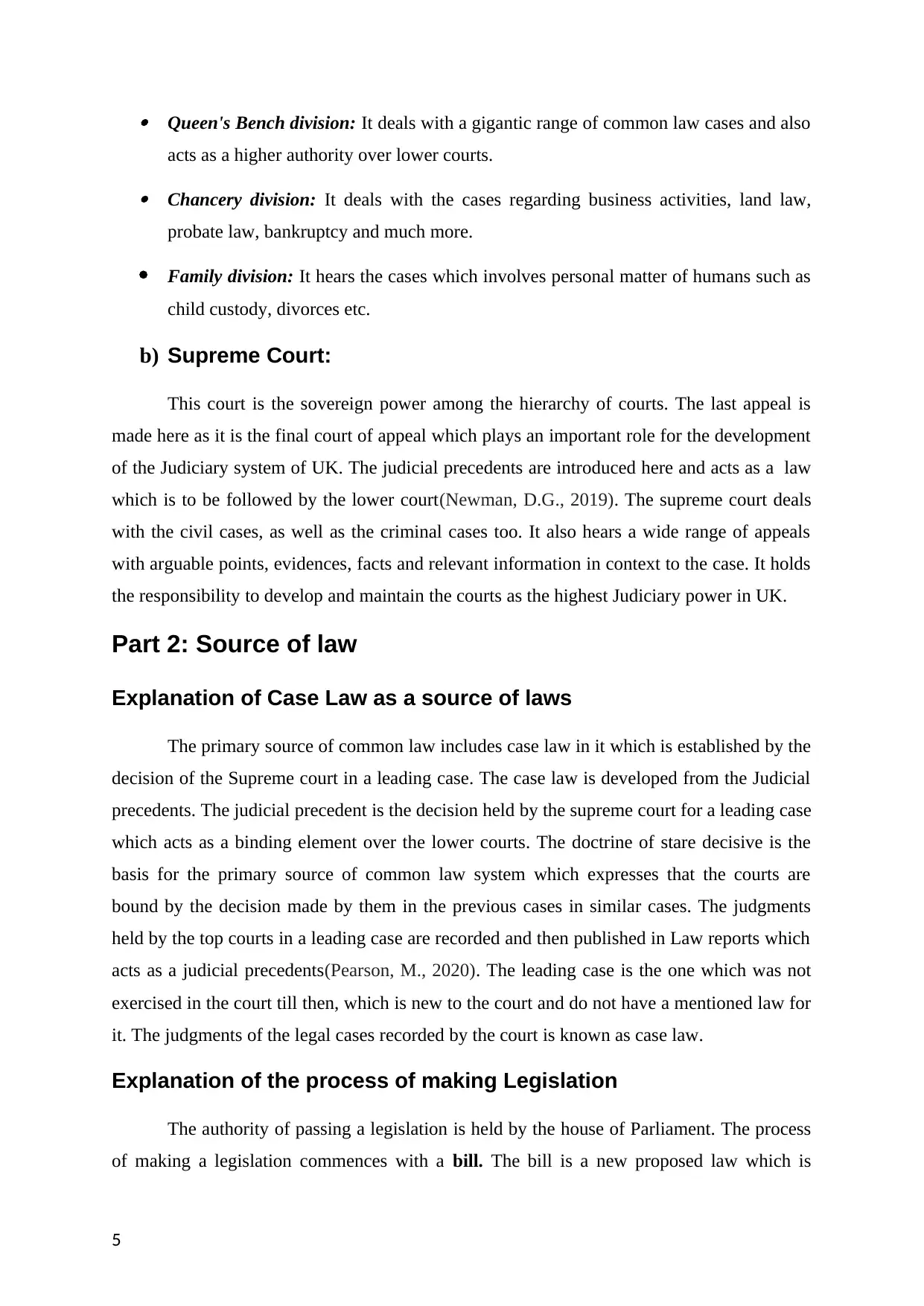
Queen's Bench division: It deals with a gigantic range of common law cases and also
acts as a higher authority over lower courts. Chancery division: It deals with the cases regarding business activities, land law,
probate law, bankruptcy and much more.
Family division: It hears the cases which involves personal matter of humans such as
child custody, divorces etc.
b) Supreme Court:
This court is the sovereign power among the hierarchy of courts. The last appeal is
made here as it is the final court of appeal which plays an important role for the development
of the Judiciary system of UK. The judicial precedents are introduced here and acts as a law
which is to be followed by the lower court(Newman, D.G., 2019). The supreme court deals
with the civil cases, as well as the criminal cases too. It also hears a wide range of appeals
with arguable points, evidences, facts and relevant information in context to the case. It holds
the responsibility to develop and maintain the courts as the highest Judiciary power in UK.
Part 2: Source of law
Explanation of Case Law as a source of laws
The primary source of common law includes case law in it which is established by the
decision of the Supreme court in a leading case. The case law is developed from the Judicial
precedents. The judicial precedent is the decision held by the supreme court for a leading case
which acts as a binding element over the lower courts. The doctrine of stare decisive is the
basis for the primary source of common law system which expresses that the courts are
bound by the decision made by them in the previous cases in similar cases. The judgments
held by the top courts in a leading case are recorded and then published in Law reports which
acts as a judicial precedents(Pearson, M., 2020). The leading case is the one which was not
exercised in the court till then, which is new to the court and do not have a mentioned law for
it. The judgments of the legal cases recorded by the court is known as case law.
Explanation of the process of making Legislation
The authority of passing a legislation is held by the house of Parliament. The process
of making a legislation commences with a bill. The bill is a new proposed law which is
5
acts as a higher authority over lower courts. Chancery division: It deals with the cases regarding business activities, land law,
probate law, bankruptcy and much more.
Family division: It hears the cases which involves personal matter of humans such as
child custody, divorces etc.
b) Supreme Court:
This court is the sovereign power among the hierarchy of courts. The last appeal is
made here as it is the final court of appeal which plays an important role for the development
of the Judiciary system of UK. The judicial precedents are introduced here and acts as a law
which is to be followed by the lower court(Newman, D.G., 2019). The supreme court deals
with the civil cases, as well as the criminal cases too. It also hears a wide range of appeals
with arguable points, evidences, facts and relevant information in context to the case. It holds
the responsibility to develop and maintain the courts as the highest Judiciary power in UK.
Part 2: Source of law
Explanation of Case Law as a source of laws
The primary source of common law includes case law in it which is established by the
decision of the Supreme court in a leading case. The case law is developed from the Judicial
precedents. The judicial precedent is the decision held by the supreme court for a leading case
which acts as a binding element over the lower courts. The doctrine of stare decisive is the
basis for the primary source of common law system which expresses that the courts are
bound by the decision made by them in the previous cases in similar cases. The judgments
held by the top courts in a leading case are recorded and then published in Law reports which
acts as a judicial precedents(Pearson, M., 2020). The leading case is the one which was not
exercised in the court till then, which is new to the court and do not have a mentioned law for
it. The judgments of the legal cases recorded by the court is known as case law.
Explanation of the process of making Legislation
The authority of passing a legislation is held by the house of Parliament. The process
of making a legislation commences with a bill. The bill is a new proposed law which is
5
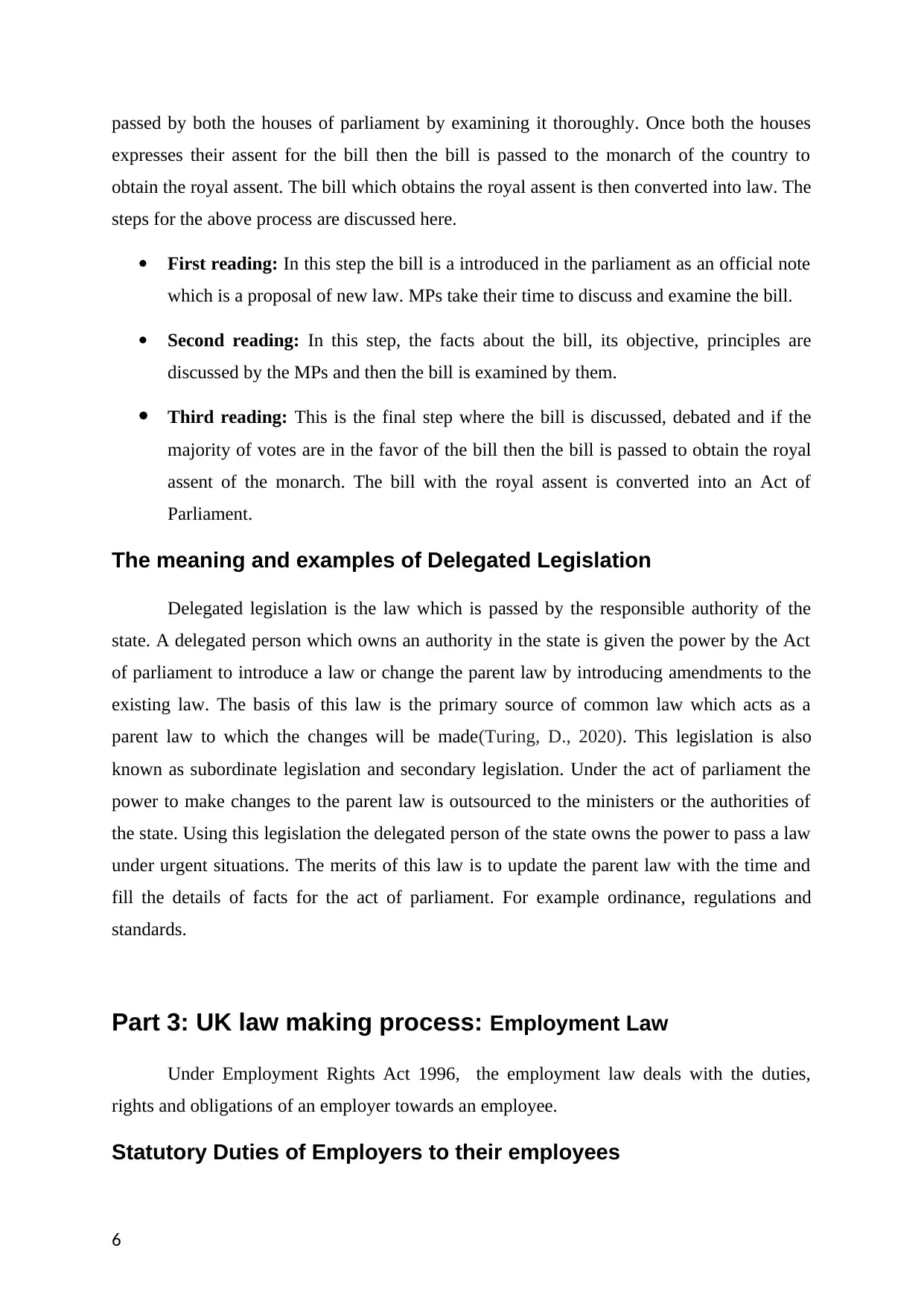
passed by both the houses of parliament by examining it thoroughly. Once both the houses
expresses their assent for the bill then the bill is passed to the monarch of the country to
obtain the royal assent. The bill which obtains the royal assent is then converted into law. The
steps for the above process are discussed here.
First reading: In this step the bill is a introduced in the parliament as an official note
which is a proposal of new law. MPs take their time to discuss and examine the bill.
Second reading: In this step, the facts about the bill, its objective, principles are
discussed by the MPs and then the bill is examined by them.
Third reading: This is the final step where the bill is discussed, debated and if the
majority of votes are in the favor of the bill then the bill is passed to obtain the royal
assent of the monarch. The bill with the royal assent is converted into an Act of
Parliament.
The meaning and examples of Delegated Legislation
Delegated legislation is the law which is passed by the responsible authority of the
state. A delegated person which owns an authority in the state is given the power by the Act
of parliament to introduce a law or change the parent law by introducing amendments to the
existing law. The basis of this law is the primary source of common law which acts as a
parent law to which the changes will be made(Turing, D., 2020). This legislation is also
known as subordinate legislation and secondary legislation. Under the act of parliament the
power to make changes to the parent law is outsourced to the ministers or the authorities of
the state. Using this legislation the delegated person of the state owns the power to pass a law
under urgent situations. The merits of this law is to update the parent law with the time and
fill the details of facts for the act of parliament. For example ordinance, regulations and
standards.
Part 3: UK law making process: Employment Law
Under Employment Rights Act 1996, the employment law deals with the duties,
rights and obligations of an employer towards an employee.
Statutory Duties of Employers to their employees
6
expresses their assent for the bill then the bill is passed to the monarch of the country to
obtain the royal assent. The bill which obtains the royal assent is then converted into law. The
steps for the above process are discussed here.
First reading: In this step the bill is a introduced in the parliament as an official note
which is a proposal of new law. MPs take their time to discuss and examine the bill.
Second reading: In this step, the facts about the bill, its objective, principles are
discussed by the MPs and then the bill is examined by them.
Third reading: This is the final step where the bill is discussed, debated and if the
majority of votes are in the favor of the bill then the bill is passed to obtain the royal
assent of the monarch. The bill with the royal assent is converted into an Act of
Parliament.
The meaning and examples of Delegated Legislation
Delegated legislation is the law which is passed by the responsible authority of the
state. A delegated person which owns an authority in the state is given the power by the Act
of parliament to introduce a law or change the parent law by introducing amendments to the
existing law. The basis of this law is the primary source of common law which acts as a
parent law to which the changes will be made(Turing, D., 2020). This legislation is also
known as subordinate legislation and secondary legislation. Under the act of parliament the
power to make changes to the parent law is outsourced to the ministers or the authorities of
the state. Using this legislation the delegated person of the state owns the power to pass a law
under urgent situations. The merits of this law is to update the parent law with the time and
fill the details of facts for the act of parliament. For example ordinance, regulations and
standards.
Part 3: UK law making process: Employment Law
Under Employment Rights Act 1996, the employment law deals with the duties,
rights and obligations of an employer towards an employee.
Statutory Duties of Employers to their employees
6
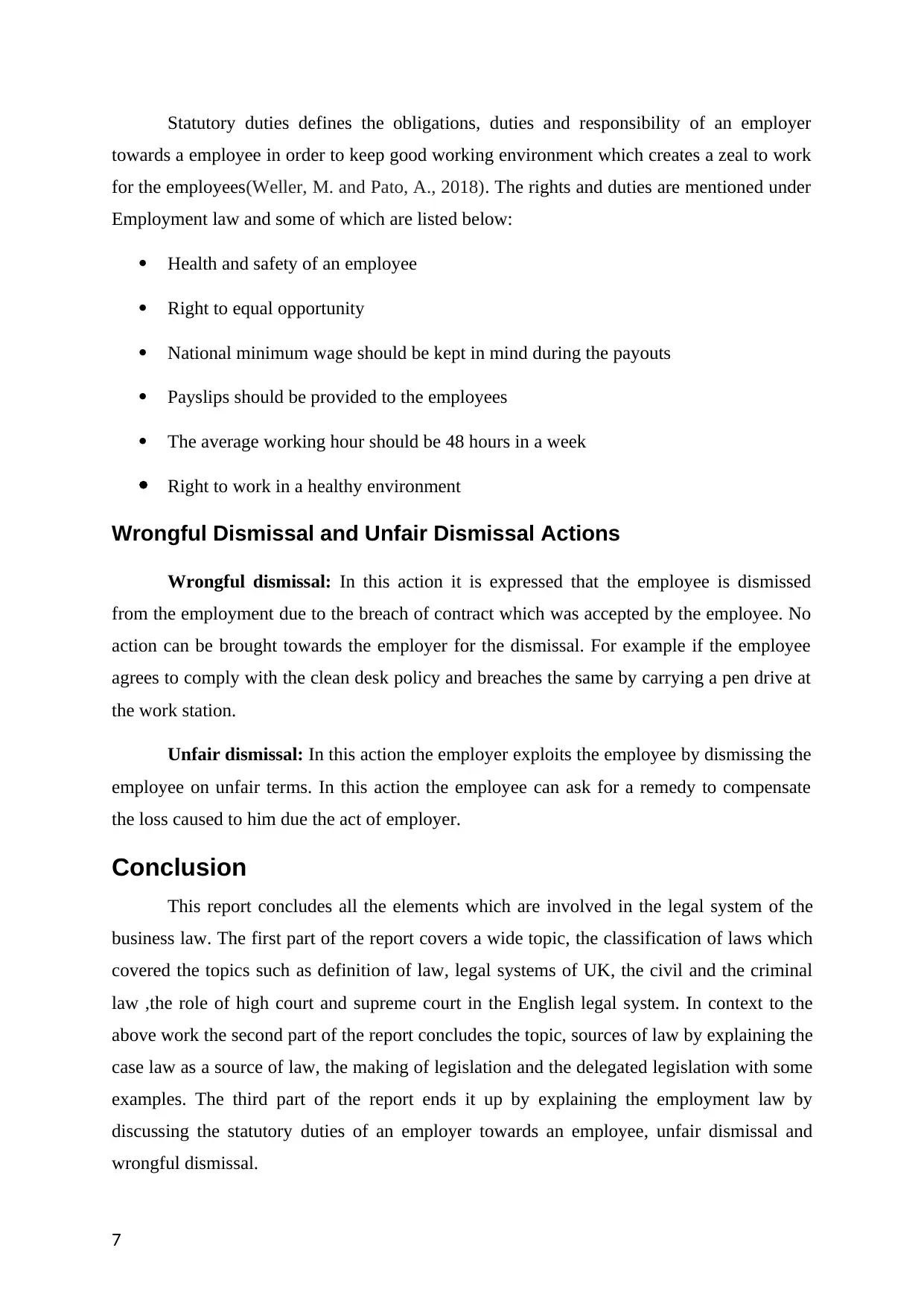
Statutory duties defines the obligations, duties and responsibility of an employer
towards a employee in order to keep good working environment which creates a zeal to work
for the employees(Weller, M. and Pato, A., 2018). The rights and duties are mentioned under
Employment law and some of which are listed below:
Health and safety of an employee
Right to equal opportunity
National minimum wage should be kept in mind during the payouts
Payslips should be provided to the employees
The average working hour should be 48 hours in a week
Right to work in a healthy environment
Wrongful Dismissal and Unfair Dismissal Actions
Wrongful dismissal: In this action it is expressed that the employee is dismissed
from the employment due to the breach of contract which was accepted by the employee. No
action can be brought towards the employer for the dismissal. For example if the employee
agrees to comply with the clean desk policy and breaches the same by carrying a pen drive at
the work station.
Unfair dismissal: In this action the employer exploits the employee by dismissing the
employee on unfair terms. In this action the employee can ask for a remedy to compensate
the loss caused to him due the act of employer.
Conclusion
This report concludes all the elements which are involved in the legal system of the
business law. The first part of the report covers a wide topic, the classification of laws which
covered the topics such as definition of law, legal systems of UK, the civil and the criminal
law ,the role of high court and supreme court in the English legal system. In context to the
above work the second part of the report concludes the topic, sources of law by explaining the
case law as a source of law, the making of legislation and the delegated legislation with some
examples. The third part of the report ends it up by explaining the employment law by
discussing the statutory duties of an employer towards an employee, unfair dismissal and
wrongful dismissal.
7
towards a employee in order to keep good working environment which creates a zeal to work
for the employees(Weller, M. and Pato, A., 2018). The rights and duties are mentioned under
Employment law and some of which are listed below:
Health and safety of an employee
Right to equal opportunity
National minimum wage should be kept in mind during the payouts
Payslips should be provided to the employees
The average working hour should be 48 hours in a week
Right to work in a healthy environment
Wrongful Dismissal and Unfair Dismissal Actions
Wrongful dismissal: In this action it is expressed that the employee is dismissed
from the employment due to the breach of contract which was accepted by the employee. No
action can be brought towards the employer for the dismissal. For example if the employee
agrees to comply with the clean desk policy and breaches the same by carrying a pen drive at
the work station.
Unfair dismissal: In this action the employer exploits the employee by dismissing the
employee on unfair terms. In this action the employee can ask for a remedy to compensate
the loss caused to him due the act of employer.
Conclusion
This report concludes all the elements which are involved in the legal system of the
business law. The first part of the report covers a wide topic, the classification of laws which
covered the topics such as definition of law, legal systems of UK, the civil and the criminal
law ,the role of high court and supreme court in the English legal system. In context to the
above work the second part of the report concludes the topic, sources of law by explaining the
case law as a source of law, the making of legislation and the delegated legislation with some
examples. The third part of the report ends it up by explaining the employment law by
discussing the statutory duties of an employer towards an employee, unfair dismissal and
wrongful dismissal.
7
Paraphrase This Document
Need a fresh take? Get an instant paraphrase of this document with our AI Paraphraser
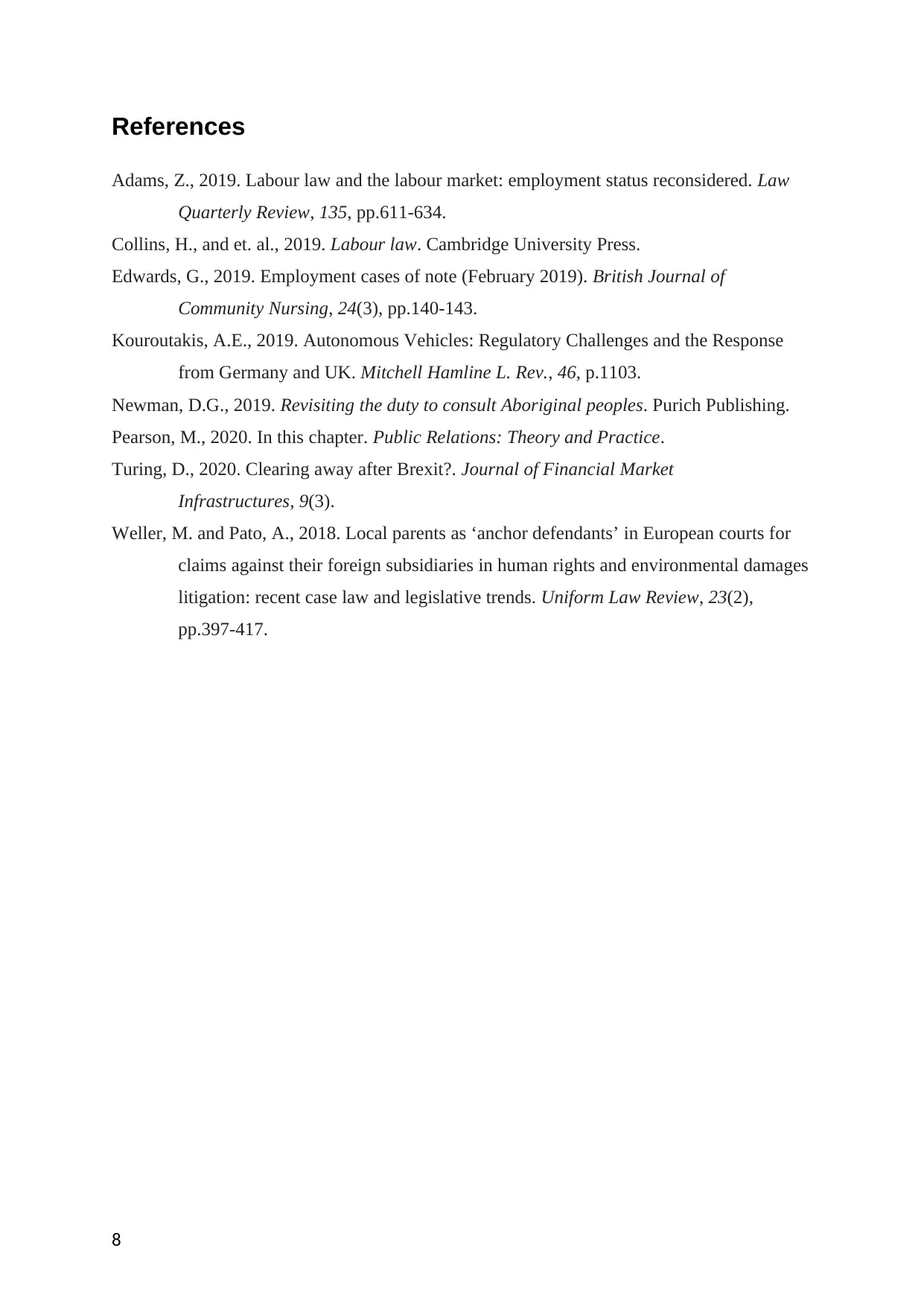
References
Adams, Z., 2019. Labour law and the labour market: employment status reconsidered. Law
Quarterly Review, 135, pp.611-634.
Collins, H., and et. al., 2019. Labour law. Cambridge University Press.
Edwards, G., 2019. Employment cases of note (February 2019). British Journal of
Community Nursing, 24(3), pp.140-143.
Kouroutakis, A.E., 2019. Autonomous Vehicles: Regulatory Challenges and the Response
from Germany and UK. Mitchell Hamline L. Rev., 46, p.1103.
Newman, D.G., 2019. Revisiting the duty to consult Aboriginal peoples. Purich Publishing.
Pearson, M., 2020. In this chapter. Public Relations: Theory and Practice.
Turing, D., 2020. Clearing away after Brexit?. Journal of Financial Market
Infrastructures, 9(3).
Weller, M. and Pato, A., 2018. Local parents as ‘anchor defendants’ in European courts for
claims against their foreign subsidiaries in human rights and environmental damages
litigation: recent case law and legislative trends. Uniform Law Review, 23(2),
pp.397-417.
8
Adams, Z., 2019. Labour law and the labour market: employment status reconsidered. Law
Quarterly Review, 135, pp.611-634.
Collins, H., and et. al., 2019. Labour law. Cambridge University Press.
Edwards, G., 2019. Employment cases of note (February 2019). British Journal of
Community Nursing, 24(3), pp.140-143.
Kouroutakis, A.E., 2019. Autonomous Vehicles: Regulatory Challenges and the Response
from Germany and UK. Mitchell Hamline L. Rev., 46, p.1103.
Newman, D.G., 2019. Revisiting the duty to consult Aboriginal peoples. Purich Publishing.
Pearson, M., 2020. In this chapter. Public Relations: Theory and Practice.
Turing, D., 2020. Clearing away after Brexit?. Journal of Financial Market
Infrastructures, 9(3).
Weller, M. and Pato, A., 2018. Local parents as ‘anchor defendants’ in European courts for
claims against their foreign subsidiaries in human rights and environmental damages
litigation: recent case law and legislative trends. Uniform Law Review, 23(2),
pp.397-417.
8
1 out of 8
Related Documents
Your All-in-One AI-Powered Toolkit for Academic Success.
+13062052269
info@desklib.com
Available 24*7 on WhatsApp / Email
![[object Object]](/_next/static/media/star-bottom.7253800d.svg)
Unlock your academic potential
© 2024 | Zucol Services PVT LTD | All rights reserved.


